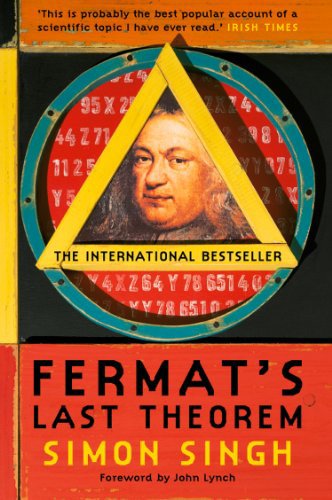Math has never been so thrilling.
Side note: I am finally publishing this old old draft because I need to air out this blog

Recognised as a classic of popular science writing, FERMAT’s LAST THEOREM is the story of a riddle that confounded the world’s greatest minds for 358 years. Combining thrilling storytelling with a fascinating history of scientific discovery, Simon Singh tells how an Englishman, after years of secret toil, finally solved mathematics’ most challenging problem.
Passion in Writing
I’ve been sitting on this book review for literal months. I bought this book at the last book fair I went to (I think it was Big Bad Wolf Book Sale), and finished it right away. I could never figure out how to fully express the suspense and delight and love I felt when I was reading this book.
I think that reading a book on such a specific subject –a subject that others might call boring– with such passionate tones and enthusiasm is already a worthwhile experience in itself. Never in a million years did I expect a book about math would make me grip my seats in suspense.
A big chunk of this book is simply lively storytelling. It somehow moved from Pythagoras to Euclid to other names I now cannot recall (but I can easily flip back to, thanks to the book’s helpful index) in a seamless manner. It’s not a textbook. It’s a story that just happens to be very informative about mathematical concepts and history.
The Book’s Mystery
To actually give you an idea about what the book talks about, I have to start a couple of thousand years in the past. This guy called Pythagoras changed the world when he came up with this theorem on triangles and space: x2 + y2 = z2. This is always true.
In the late 1600s, Fermat –a brilliant but lazy genius, it seems– contemplated a variant of the famous theorem: x3 + y3 = z3. According to Fermat’s titular theorem, this equation is never true. That is, there will never be a solution that fulfills the Fermatean triple xn + yn = zn where n represents 3,4,5…
Theorems and conjectures come and go. Their strength comes from their proof. Unlike in science, where proving laws relies on experimentation and reproducibility, mathematical laws rely on derivation and pure logic. Unlike scientific proofs, mathematical proofs can’t be proven wrong once they are accepted as correct. Once a mathematician logically proves a theorem using established axioms and logical steps, it is regarded as truth forever. (Unless you feel like shaking up the entire foundation of mathematics).
According to the book, Fermat’s creation would have been lost in the rubble of time –had he not written this sensational statement in the margins of a book: “Cuius rei demonstrationem mirabilem sane detexi hanc marginis exiguitas non caperet.”
I have a truly marvellous demonstration of this proposition which this margin is too narrow to contain.
And before he could show his proof to the world… he died.
Four hundred years and dozens of mathematicians vying for an answer later, a man called Andrew Wiles would be presenting a nerve-wracking proof to this centuries-old cliffhanger.
This is the nail-biting mystery that gives the book its strength. It goes through the several eras of mathematical discoveries that are directly or indirectly tied to the Last Theorem.
The author was able to make math interesting through the ages, which is more than I can say for more fantastical science books, and they were also able to translate math to the point of understanding. The book even has an appendix filled with basic proofs and mathematical know-how.
The novel finally comes back to its beginning scene, which is the stage where Andrew Wiles was presenting years’ worth of proof to colleagues and contemporary mathematical proofs. Obsessed with the old problem since his childhood, he toiled in secrecy and isolation for almost a decade.
“It was the most important mathematical lecture of the century.” But in an anxiety-inducing turn of events, his momentous proof had a fatal error.
You can easily search how the story ends, but I’ll leave you in suspense.
Appendix
As an appendix to this review, I want to share some other things I love about the book:
- The book has an appendix, featuring the Riddle of Diophantus’ Age, the axioms of arithmetic, and more. I love learning. I also love appendices and footnotes.
- This book is almost as old as me. I love books.
- It features some Asians. So there’s that, I guess.
I recommend this book if you love learning, even if it’s mostly theoretical, and if you love exercising your brain muscles. This is a sincerely earnest and clever attempt at bringing high stakes to an otherwise unremarkable paragraph in history.
If you have the chance, please read this awesome book. Also, recommend similar books down the comments below!

Say something back.